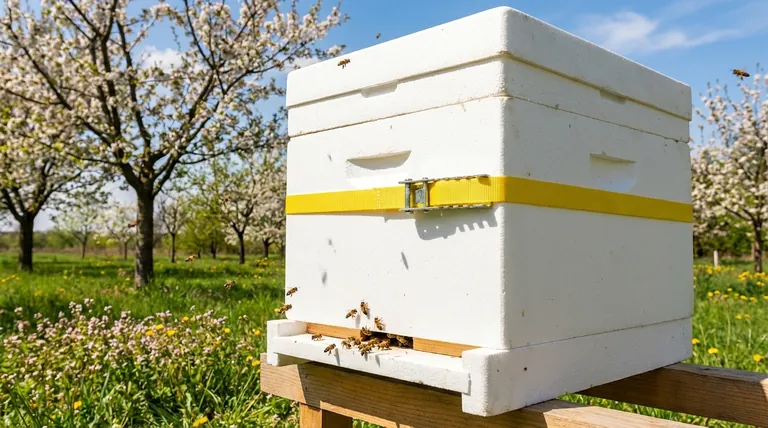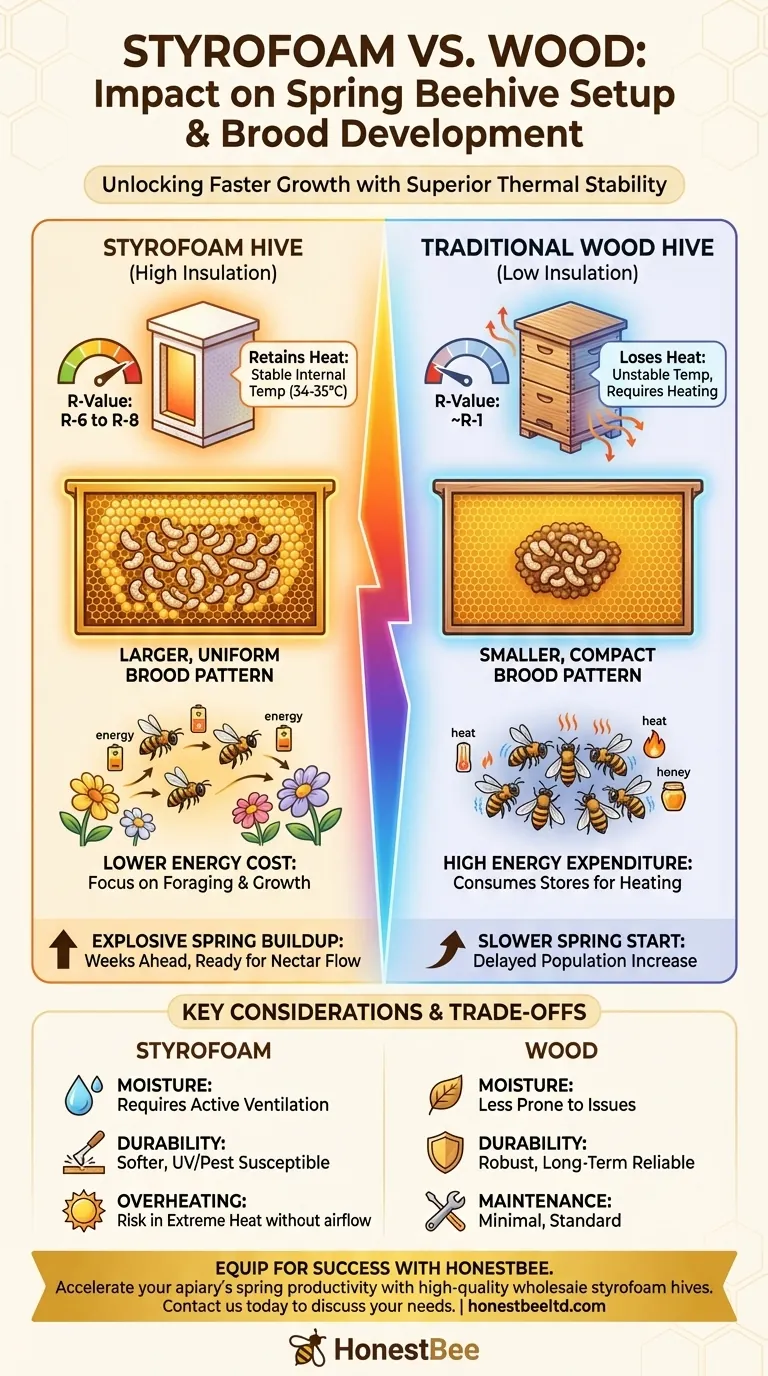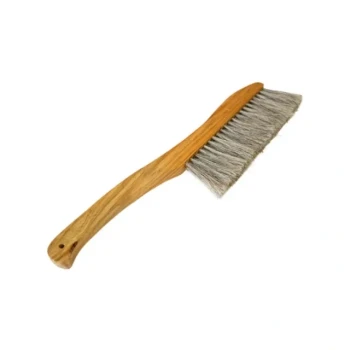In short, styrofoam beehives have a significant positive impact on spring setup and brood development. Their superior insulation creates a warmer, more stable internal environment, allowing the colony to build its population much faster and more efficiently than in traditional wooden hives. This results in a larger workforce ready for the first spring nectar flow.
The core advantage of styrofoam is not just warmth, but thermal stability. By drastically reducing the energy bees must expend to maintain the brood nest temperature, the colony can redirect its resources toward what matters most in spring: raising the next generation of foragers.

How Insulation Drives Early Spring Growth
The primary functional difference between a styrofoam (polystyrene or "poly") hive and a wooden hive is its insulation value, or R-value. A typical poly hive has an R-value of around R-6 to R-8, while a standard ¾-inch pine wood hive is only around R-1. This massive difference has direct consequences for the colony.
Reduced Energy Expenditure
A honey bee colony must maintain its central brood nest at a consistent 34-35°C (93-95°F). In a wooden hive during a cool spring, the colony expends enormous amounts of energy (by consuming honey and "shivering") to generate heat that is immediately lost to the outside air.
In a styrofoam hive, this heat is retained. This frees up the bees from excessive heating duties and allows them to focus on other critical tasks like foraging, nursing, and wax production.
A Larger, More Consistent Brood Pattern
This thermal stability encourages the queen to lay a more expansive brood pattern. Because the temperature is uniform even on the outer frames, she is more willing to lay eggs from edge to edge.
In a cold wooden hive, the outer frames are often too cold, forcing the queen to lay in a smaller, more compact circle in the center of the hive. A larger brood area directly translates to a higher population.
Faster Population Buildup
The combination of reduced energy cost and a larger laying area results in explosive spring growth. Colonies in styrofoam hives often emerge from winter stronger and can build up their numbers weeks ahead of colonies in wooden hives. This is a critical advantage for capitalizing on early nectar flows.
Understanding the Trade-offs
While the thermal benefits are clear, styrofoam hives are not without their challenges. Objectivity requires acknowledging their potential downsides compared to traditional wood.
Moisture Management is Critical
Superior insulation can also trap moisture. Bee respiration releases a significant amount of water vapor, which can condense on cold inner surfaces. If not properly ventilated, this can lead to mold growth and stress on the colony.
Effective management requires ensuring adequate ventilation, often through a slightly open entrance, a screened bottom board, or a ventilated top cover.
Durability and Handling
Styrofoam is softer than wood and can be easily damaged by hive tools during inspections. It is also susceptible to damage from pests like wax moths or rodents if the hive's integrity is compromised.
Most styrofoam hives must be painted with an exterior latex paint to protect them from UV degradation, which can make the material brittle over time.
Potential for Overheating
In very hot climates, the hive's excellent insulation can become a liability if ventilation is poor. Bees will be forced to expend energy cooling the hive through fanning and bearding on the exterior, negating some of the material's benefits.
Is a Styrofoam Hive Right for Your Apiary?
Making the right choice depends entirely on your climate, management style, and beekeeping goals. There is no single "best" answer, only the best fit for your specific situation.
- If your primary focus is maximizing early spring buildup for pollination or a strong nectar flow: Styrofoam provides a distinct and proven advantage due to its superior thermal performance.
- If your primary focus is long-term durability and minimal maintenance: Traditional wood hives remain a robust and reliable standard, though you may see a slower start in the spring.
- If you are in a climate with high humidity or extreme summer heat: Styrofoam can be highly effective, but only if you commit to providing excellent ventilation to manage moisture and prevent overheating.
Ultimately, understanding the properties of your equipment empowers you to make management decisions that lead to healthier, more productive colonies.
Summary Table:
| Feature | Styrofoam Hive Impact | Traditional Wood Hive Impact |
|---|---|---|
| Thermal Insulation | High (R-6 to R-8), retains heat | Low (R-1), loses heat quickly |
| Spring Brood Development | Faster, larger, more uniform pattern | Slower, smaller, compact pattern |
| Colony Energy Use | Lowers energy spent on heating | High energy expenditure on heating |
| Key Consideration | Requires active moisture management | Less prone to moisture issues |
Ready to give your colonies the spring advantage they need?
For commercial apiaries and beekeeping equipment distributors, faster spring buildup is a direct path to higher productivity and profitability. HONESTBEE supplies high-quality, durable styrofoam beehives and the full range of beekeeping supplies through our wholesale-focused operations.
Let us help you equip your operation for success. Contact HONESTBEE today to discuss your wholesale needs and unlock the benefits of superior hive insulation.
Visual Guide

Related Products
- Professional Galvanized Hive Strap with Secure Locking Buckle for Beekeeping
- Professional Grade Foldable Beehive Handles
- Professional Drop-Style Hive Handles for Beekeeping
- Mesh Ventilated 3 Layer Goatskin Beekeepers Gloves for Beekeeping
- Endless Loop Ratchet Hive Strap
People Also Ask
- How should a cam buckle strap be installed for optimal performance? Master the Leverage for Maximum Tension
- What are hive straps and why are they used? Secure Your Hives Against Wind, Predators, and Transport
- What is the advantage of using cam buckle straps? Secure Your Load Fast with Simple, Safe Tensioning
- Why are hive straps important for beekeepers? Secure Your Hives Against Wind, Predators & Transport
- How can beekeepers secure the top cover of a hive? Protect Your Colony from Wind and Weather



















